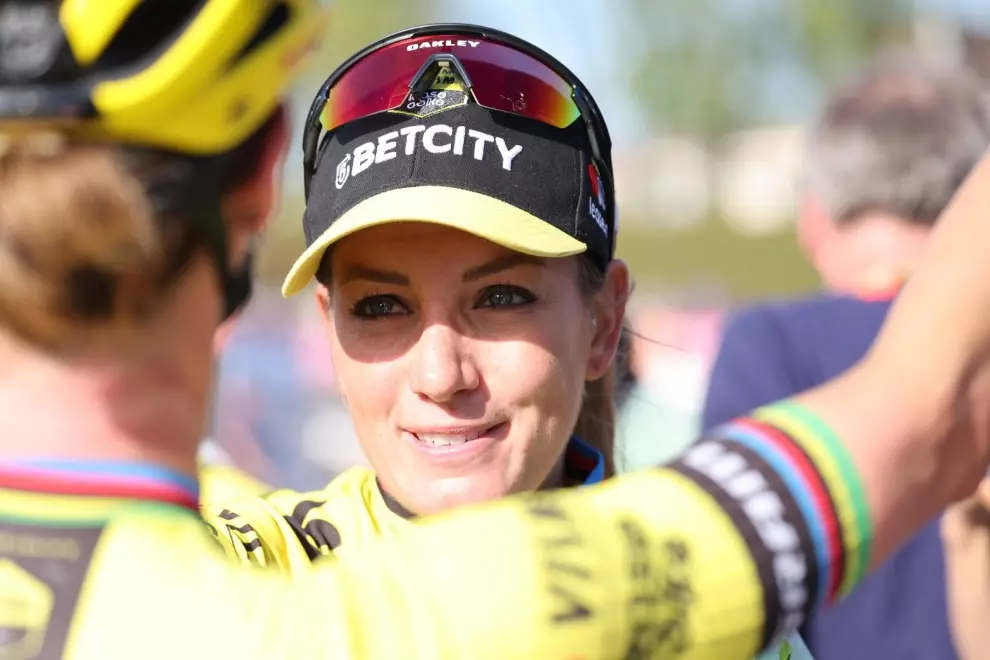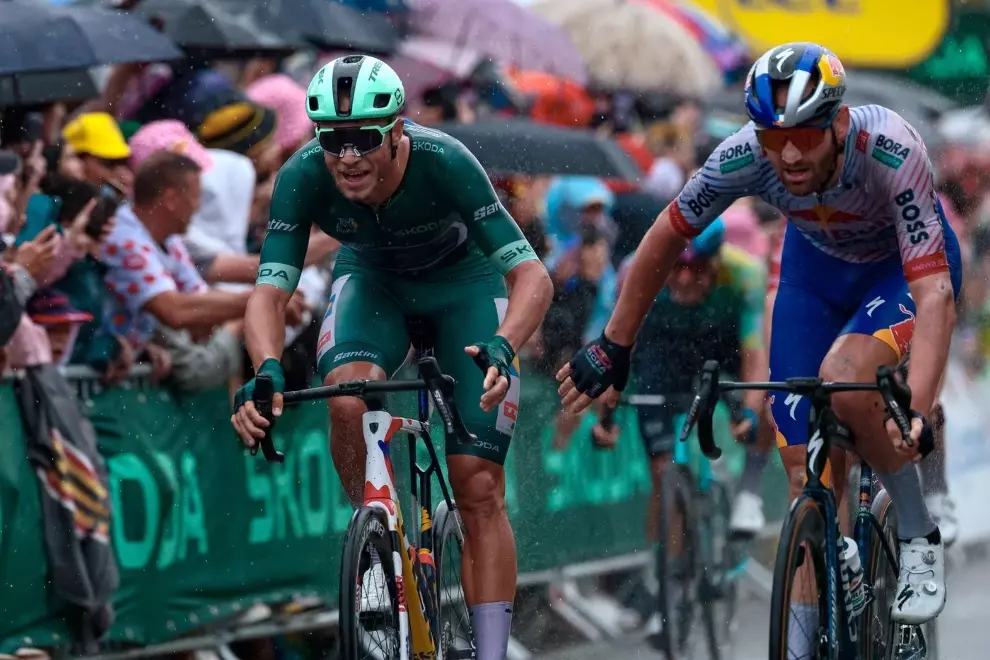8:22, and we’re off. A cheerful crowd has gathered to send us off to the most glorious event of the year—the one that takes you the closest to the magic of the Tour. The one that each ear flocks 17,000 participants to give them the ride of a lifetime.
This is L’étape du Tour de France.
The start
There’s really nothing like going through a city the size of Nice and seeing cyclists everywhere. From 7:00, when the start of the first group was given the go, a cheerful clutching of gears was noticeable throughout the main street. A divine moment of serenity that followed the late-night celebrations of France winning its quarter final against Portugal at the Euro 2024. A constant flow of cyclists took over the streets heading out of Nice to the North East. The cyclists, however, were everywhere. Different groups would start for the next 2 hours, so those starting after eight were just heading toward the starting zone.
The starting zone was right at the sea, where people usually go for their morning jog. Today, it was a bit crowded, so sorry, guy in the red shirt, for bumping into you.
At the starting zone, everyone was filled with anticipation. The adrenaline was pumping, and just as we started moving toward the start, a loud bang filled the air. Thankfully, it wasn’t a terrorist attempt. Sadly, it was the first of many exploded tires of the day. A sigh of compassion was heard throughout the crowd. But C’est la vie, the show must go on.
At precisely 8:22:30, the start was given, and our group of 1,000 riders stormed the streets. What a glorious moment. What a rush.
Despite the early hours, there were a lot of people around the city who had come to send us off. And that was just the beginning.

The first 20K
As usual, the start was fast. Some rushed forward to catch the front group, which was precisely 7 minutes in front. Others took the time to enjoy the moment. Many made videos and pictures; some even stopped right after the start to take a picture with Didi the Devil. Were they selling their souls? I can’t speculate.
The race was off. The First 20K were all about finding your group. People started gathering, riding together, pulling each other. It was like a mini Tour de France, where everyone tried to get behind one wheel or the other. The pace was fast, and the hopes were high. The first col of the day was the small and not very challenging Col du Nice, which started showing who were the climbers and who were the pacers.
After the bump, the race finally headed toward the first categorized climb of the day.
The climbs
The climbs were the main event. I mean, you know what you’ve gotten into when you look back from right before the top, and you see the entire road behind filled with cyclists struggling to conquer the 10km. 6% Col. Just like ants, they were organized but at the same time chaotic. A beautiful picture, a mesmerizing view.
Right at the top, it started showering. A light shower to refresh the contenders before the 10k-long steep descent towards the main event – Col du Turini. This 20k climb was a formidable enemy that would spell the doom of many riders. Mine as well. But I’m getting ahead of myself.
The first 7km flew by as the breakfast slowly got burned away, and the guts started screaming for food. Thankfully, at the 53rd km, or 7 km after the start of the vicious climb, the organizers were prepared with some food and drinks.
To be honest, the food was nothing too special. Sweet and salty cakes, some fruit and a lot of water. Of course, it was a nice touch, and the people working there were extremely nice. The entire atmosphere was awesome, with some children encouraging the cyclists, who decided to keep on pushing without stopping.
After a short rest, it was time to begin this grueling task. The climb was long—not very hard, but long. Ambulances were flying left and right as the clouds subsided, and the sun was reminding us all that it was summer and it was noon.
On the other hand, this was a great time to talk to some people. After all, what else can you do when you are being overtaken with a 0.2kph speed difference?
“How long to the Top?” I asked Oliver from France, a guy I’ve been riding with for about 15 minutes.
“500 m”, he answered.
And just as I felt some relief, a guy next to us, pushing his legs to the limit, told us that the broom wagon was just two turns behind. We both stood up, changed to higher gear, and pushed ourselves to the limit.
It was like a real race.
And we managed. We climbed the top before the boom wagon, and with a sigh of relief, we began the 20km descent towards the valley.
Just as we thought we had made the cut after the descent, the organizers pulled the barrier, snuffing the hopes of thousands.
The disappointment
Disappointed is way too lenient. I was devastated. After last year the heat took my chances at Col de la Ramma, this year, I rode much more conservatively. Sure, I wanted to conserve energy for the last climb but also be able to take on Col de la Colmiane at a relatively good speed. This 7 km climb was a bump on the road, but it had a formidable 7.1% average gradient. So, I knew I had to keep my legs fresh for it if I were to take it without stopping.
Unfortunately, after 6 hours of riding and feeling ready to start pushing myself, the organizers decided that I had enough. They decided that for thousands of participants. I was sure I could manage to get into the 11-hour cut by the finish line.
But that’s not what the organizers had in mind.
Some critiques
I was not the only one who was disappointed. Speaking to some other disqualified participants, they were also flabbergasted by the decision to cut them right after the toughest climb.
“I mean, cutting me off at the climb, I can understand, but after the descent, what’s the point?” one of them explained.
“Did they forget this was an amateur race?” another one exclaimed.
“So, practically, they give less time for the slower folks to finish the race. I mean, If you start at 9:00, you have 2 hours less to cover a particular distance. Yet you are placed to start at 9:00 if you are not among the fastest riders. So, they set you up to fail,” another disappointed rider told me.
Many others, though, were happy it was all over.
“Yeah, I wasn’t going to make it,” said a rider, who was obviously already done with the race.
“Better here than on the next climb,” another one agreed.
“That’s quite normal. I was way off my target and way too slow on the descent. I wasn’t expecting so many technical curves.”
And the curves were truly dangerous. At one point a rider even crashed into the barrier, while another one just flew off the side. I actually wasn’t there, but some riders at the bottom told me that he simply flew off the corner and wasn’t able to slow down.
Cycling is dangerous. You should never forget that, especially on steep descents.
On the last descent, an emergency team urged us to slow down while climbers tried to retrieve the person who had flown off the edge. Soon after, several helicopters flew above us to collect the injured. Hopefully, the rider who crashed is OK, and they will recover.
So, this being said, it was not all about criticizing.
Job well done
Despite some riders’ disappointment and valid critiques, the overall organization was more than well done. Emergency teams were constantly looking for issues; ambulances flew by and cared for those in need. Everyone spoke pretty good English as well. Organizing 17,000 people is definitely not an easy job. So, kudos on that.
Moreover, after being disqualified, you had the choice to get back home on a relatively flat road, as you had to cover about 60 km. Or you could go to the top with your bike, as there were buses and trucks, to take care of everyone who didn’t manage to finish.
And let’s not forget the fans. That’s what makes this experience unlike any other.
Being cheered on by entire villages is definitely something to look forward to. Whether spraying you with water, giving you high fives, or simply clapping and making some noise, the fans are simply awesome. They are the one thing that will always bring me back to L’etape, no matter how disappointed I am with my performance or the minor issues with the organization.
It was another great L’Étape
Winners or losers, L’Étape is definitely worth the effort. It brings you one step closer to what the pros go through on their way to Paris… well this year, it’s Nice. And Nice is, without a doubt, one place where you should visit for a quick cycling tour, even outside an organized event. Whether you go to Monaco, Cannes, or just straight north to the mountain passes and canyons, the Maritime Alps are some of the most picturesque places you can visit. So, Nice, I’ll definitely return. L’etape- see you next year.





